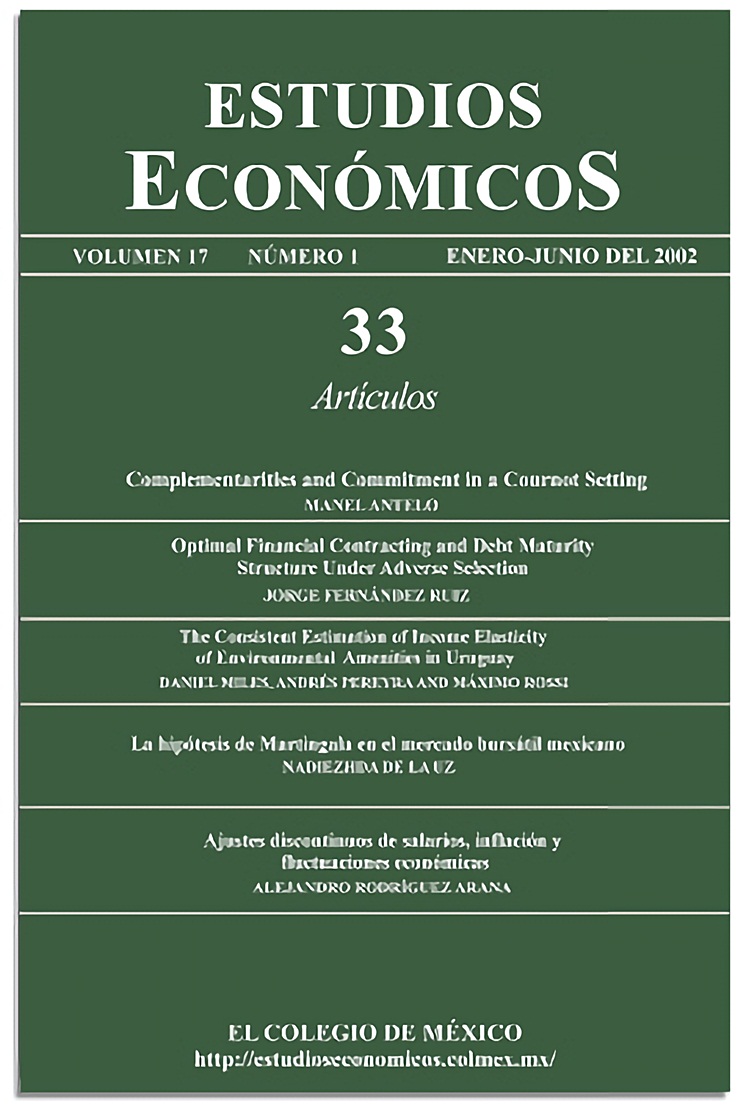Artículos
La estimación consistente de la elasticidad ingreso de los bienes ambientales en Uruguay
Publicado 2002-01-01
Palabras clave
- Uruguay,
- econometría,
- elasticidades
Cómo citar
Miles, D., Pereyra, A., & Rossi, M. (2002). La estimación consistente de la elasticidad ingreso de los bienes ambientales en Uruguay. Estudios Económicos De El Colegio De México, 17(1), 67–89. https://doi.org/10.24201/ee.v17i1.198
Resumen
Estamos interesados en la estimación de la elasticidad ingreso de la demanda de bienes ambientales. Resulta novedoso la aplicación de métodos econométricos que toman en cuenta el problema de los errores de medición cuando se estiman dichas elasticidades, errores que son frecuentes en los datos microeconómicos, y que no son totalmente considerados en la literatura sobre el tema. Nuestro objetivo es discutir si el error de medición tiene un efecto significativo en las elasticidades. Se utiliza información de la Encuesta de gastos e ingresos, 1994 - 1995, realizada por el Instituto Nacional de Estadística.
Descargas
Los datos de descargas todavía no están disponibles.
Citas
- Banks, J., R. Blundell, and A. Lewbel (1997). “Quadratic Engel curves and consumer demand”, The Review of Economics and Statistics, 79.
- Costa, D. (1997). Less of a luxury: the rise of recreation since 1888, NBER, Working Paper 6054.
- Curiel, F. (1997). La elasticidad de la renta del gasto en recreación ambiental, Universidad Autónoma de Barcelona (manuscript).
- Deaton, A. and J. Muellbauer (1980). Economics and consumer behaviour, Cambridge University Press.
- Flores, N. and R. Carson (1995). The relationship between the income elasticities of demand and willingness to pay, University of California, (manuscript).
- Fry, V. and P. Pashardes (1992). An almost ideal quadratic logarithmic demand system for the analysis of microdata, Oxford Applied Economic Discussion Paper Series, 145.
- Gorman, W. M. (1981). “Some Engel curves”, in A. Deaton, (ed.), The theory and measurement of consumer behavior, Cambridge, Cambridge University Press.
- Hausman, J. et al. (1991). “Identification and estimation of polynominal errors in variables models”, Journal of Econometrics, 50.
- Hsiao, Ch. and Q. Wang (2000). “Estimation of structural nonlinear errors in variables models by simulated least squares method”, International Economic Review, 41 (2), pp. 523-542.
- Instituto Nacional de Estadística (1996). Encuesta de gastos e ingresos, 1994-1995, Montevideo.
- Kriström, B. and P. Riera (1997). Income distribution and willingness to pay for environmental goods: some empirical evidence, Universidad Autónoma de Barcelona, (manuscript).
- Kriström, B. and P. Riera (1996). “Is income elasticity of environmental improvements less than one?”, Environmental Resource Economics, 7 (1), pp. 45-55.
- Lewbel, A. (1987). “Characterizing some Gorman-Engel curves”, Econometrica, 55, 4, pp. 1451-1459.
- Lewbel, A. (1996). “Demand Estimation with expenditure measurement errors on left and right hand side”. The Review of Economics and Statistics, 78 (4), pp. 718-725.
- Mammen, E. (1993). “Bootstrap and wild bootstrap for high dimensional linear models”, The Annals of Statistics, 21, pp. 255-285.
- Meghir, C. and J. M. Robin (1992). “Frequency of purchase and estimation of demand systems”, Journal of Econometrics, 53.
- Miles, D. (1998). Especificación e inferencia en modelos econométricos de curvas de Engel, PhD dissertation, Universidad Carlos III, Spain.
- Newey, W. (1992). Distribution free simulated moment estimation of nonlinear error in variables models, MIT, (mimeo).
- Phlips, L. (1983). Applied consumption analysis. Advanced textbooks in economics, North Holland.
- Pereyra, A. and M. Rossi (1998). ¿Los bienes ambientales constituyen un bien de lujo?, DT 13/98, Universidad de Uruguay.
- Pollak, R. and T. Wales (1992). Demand system specification and estimation, Oxford University Press.

